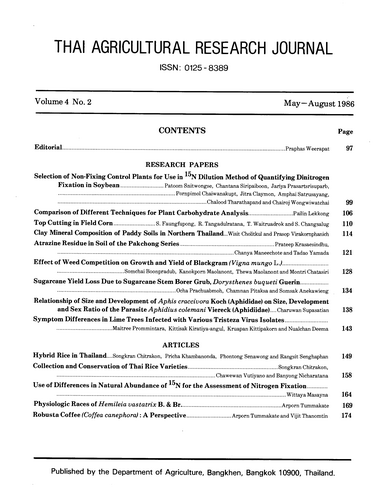Collection and Conservation of Thai Rice Varieties
Abstract
Currently the Thai government is encouraging farmers to grow rice varieties which combine a higher yield potential with increased resistance to pests and diseases. These recommended varieties are becoming increasingly popular. The replacement of the traditional varieties with new varieties is leading to concern of the potential the loss of a genetic resource. This 'Genetic Erosion', in addition to resulting in the loss of potentially good varieties, may also result in the loss of potentially valuable agronomic characters which are to be found only in local Thai varieties. To redress this threat to the rice breeding and production programme, a coordinated rice collection and conservation programme was initiated in 1982, following the establishment of a National Rice Seed Storage Laboratory for Genetic Resources in 1981. The main objective of this programme has been the collection and conservation of as many as possible of the traditional and wild rice varieties in Thailand.
The collection of traditional and wild varieties was commenced in those areas where there was an active policy being pursued of introducing HYV's, and in areas where the traditional and wild varieties are repidly declining. Collectors cooperating in the programme are from the Rice Research Institute of the Department of Agricullture, the Department of Extension, and the Department of Public Welfare. During the first five years of the programme (1982-87), a totai of 10,292 collections were made. These have comprised 3,034, 1,528, 2,021 and 1,430 from the North, Northeast, Central and Southern Regions, respectively. A further 2,282 samples were collected but not identified as to their location. Most collections to date have been non-glutinous lowland rices. Some 386 wild forms have also been collected.
The 10,292 collections made in the period 1982 - 87 have initially been kept under short-term storage conditions. A further 4,893 and 5,149 from earlier collections have been stored under medium-term and long-term conditions, respectively.
Downloads
Published
How to Cite
Issue
Section
License
Thai Agricultural Research Journal



